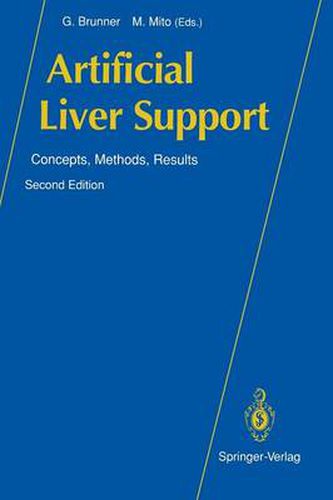Readings Newsletter
Become a Readings Member to make your shopping experience even easier.
Sign in or sign up for free!
You’re not far away from qualifying for FREE standard shipping within Australia
You’ve qualified for FREE standard shipping within Australia
The cart is loading…






This title is printed to order. This book may have been self-published. If so, we cannot guarantee the quality of the content. In the main most books will have gone through the editing process however some may not. We therefore suggest that you be aware of this before ordering this book. If in doubt check either the author or publisher’s details as we are unable to accept any returns unless they are faulty. Please contact us if you have any questions.
Continuing progress has been made since the first edition of Artificial Liver Support was published. Liver transplantation has however become an estab lished therapy for a relatively small number of patients who remain patients for life. There therefore continues to be a great need for the development of other forms of artificial liver support. Improved intensive care utilizing improved plasma exchange, dialysis, sclerotherapy, and intracranial pressure monitoring have improved survival in fulminant hepatic failure. Progress has also been made in lipid membrane detoxification, in cell cultures, and in cell transplantation, and the isolation of various liver cell growth factors has led to deep insight into the mechanisms of liver regeneration. This book gives the clinician and the researcher detailed information about established new methods of clinic work and laboratory research, and describes new experimental approaches indicating the direction of future research. G. BRUNNER M. Mno Preface to the First Edition The regenerative capacity of the liver cell is almost unlimited. Therefore after acute liver damage, be it viral, toxic, hypoxic, or surgical in origin, restitutio ad integrum is the usual outcome. In two forms of liver disease, however, this is not the case: in fulminant hepatic failure, liver regeneration often is not fast enough to keep the organism alive; in end-stage cirrhosis, regeneration is disturbed by a hypertrophic architecture of fibrotic tissue. For these extreme forms of liver disease and for critical situations before and after liver surgery, artificial liver support is needed.
$9.00 standard shipping within Australia
FREE standard shipping within Australia for orders over $100.00
Express & International shipping calculated at checkout
This title is printed to order. This book may have been self-published. If so, we cannot guarantee the quality of the content. In the main most books will have gone through the editing process however some may not. We therefore suggest that you be aware of this before ordering this book. If in doubt check either the author or publisher’s details as we are unable to accept any returns unless they are faulty. Please contact us if you have any questions.
Continuing progress has been made since the first edition of Artificial Liver Support was published. Liver transplantation has however become an estab lished therapy for a relatively small number of patients who remain patients for life. There therefore continues to be a great need for the development of other forms of artificial liver support. Improved intensive care utilizing improved plasma exchange, dialysis, sclerotherapy, and intracranial pressure monitoring have improved survival in fulminant hepatic failure. Progress has also been made in lipid membrane detoxification, in cell cultures, and in cell transplantation, and the isolation of various liver cell growth factors has led to deep insight into the mechanisms of liver regeneration. This book gives the clinician and the researcher detailed information about established new methods of clinic work and laboratory research, and describes new experimental approaches indicating the direction of future research. G. BRUNNER M. Mno Preface to the First Edition The regenerative capacity of the liver cell is almost unlimited. Therefore after acute liver damage, be it viral, toxic, hypoxic, or surgical in origin, restitutio ad integrum is the usual outcome. In two forms of liver disease, however, this is not the case: in fulminant hepatic failure, liver regeneration often is not fast enough to keep the organism alive; in end-stage cirrhosis, regeneration is disturbed by a hypertrophic architecture of fibrotic tissue. For these extreme forms of liver disease and for critical situations before and after liver surgery, artificial liver support is needed.